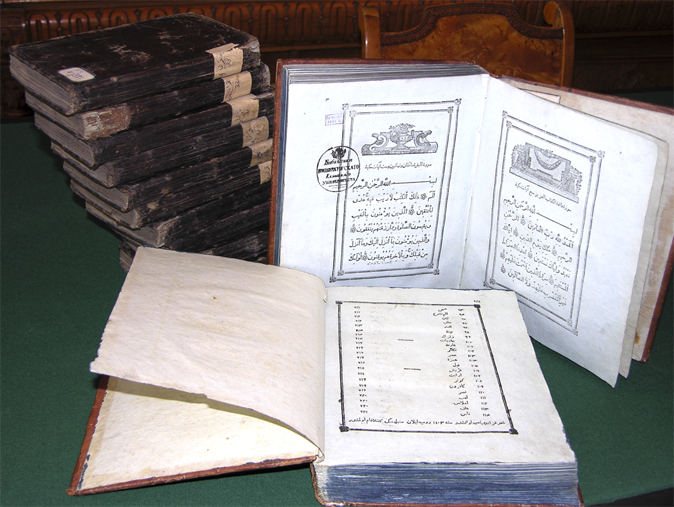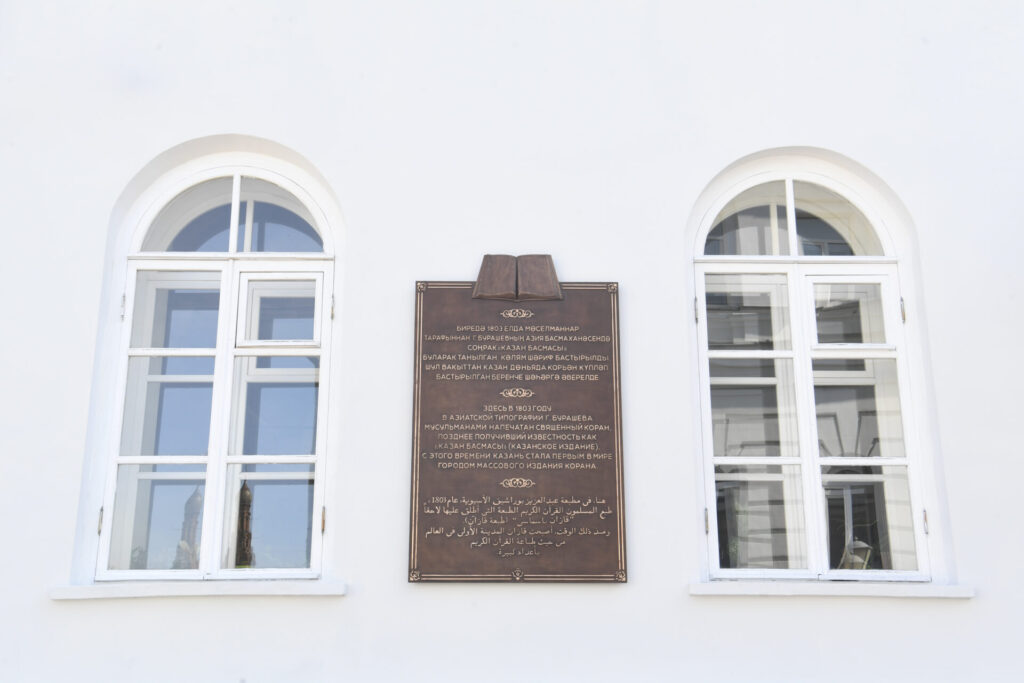The 1803 Quran for Children
04.04.2025

Today we will take a look at the “children’s” Quran, which was printed at the
very beginning of the 19th century in the Asiatic Printing House in Kazan.
In the context of Muslim culture, the Quran is regarded as the “Book of
Books,” the sacred text, and the spiritual guidance for believers. That’s why the
availability of Arabic fonts at a printing house, Kazan Muslims devoted their
efforts to printing the Quran. It is noteworthy that alongside the large two-volume
edition, which demanded significant effort in typesetting, printing, and binding, the
printing house is also preparing another format of the Quran for publication – the
so-called “children’s” version.
The provenance of such a title is of interest. The answer can be found in the
colophon, located on the final page of the last volume of this series. It is written in
Arabic script in Tatar, reading, “The Noble Speech of Allah is printed by
Gabdelgaziz Burashev based on the Emperor’s decree for children.”
The “children’s” Quran is a 10-volume set of small-sized books, with each
page designed to accommodate nine lines of text. Each volume includes three juz’.
The juz’ is one of 30 sections of roughly equal parts in the Quran, traditionally
recited one per day during the month of Ramadan.
The Quran’s unconventional format was printed on a single occasion in 1803,
with limited edition of 1,000 copies.
The narrow format of this book was advantageous not only for memorizing
the text, but also for carrying in the narrow breast pocket of a young reader’s
jacket.
The complete set of this 10-volume book is kept in the collection of the
Scientific Library of Kazan Federal University. A separate volume of the
“children’s” Quran of the only edition of 1803 is held in the collection of the Kazan
Kremlin Museum-Reserve. It was acquired in December 2023 with the assistance
of the Ministry of Culture of the Republic of Tatarstan. The previous owner had
collected 16, 17, and 18 juzas of the sixth volume, as well as 19 and 20 juzas of the
seventh volume, under one cover. And it’s not sacrilege, its common practice. This
example, which involves combining different books under one cover at the owner’s
discretion, is a common occurrence in the field of book restoration. In 2024,
restoration work was conducted, which included cleaning the sheets and binding to
remove dirt and restore any lost fragments.
These individual volumes and entire sets demonstrate the publishers’
commitment to enhancing the accessibility of the Quran for readers. This could be
considered an early form of recognizing children’s right to read, acknowledging
their access to reading material within the Tatar-Muslim cultural context.
Our subsequent publications will focus on printers, which are book
production factories.
The Quran. Volume 6 of 10. 1803. Kazan, Asian Printing House of the Imperial
Gymnasium. From the funds of the Kazan Kremlin Museum-Reserve.
Photo from the exhibition Kazan editions of the Quran in the Gallery of the Kul
Sharif Mosque of the Kazan Kremlin Museum-Reserve.
**Materials provided by the State Budgetary the Kazan Kremlin Museum-Reserve.
very beginning of the 19th century in the Asiatic Printing House in Kazan.
In the context of Muslim culture, the Quran is regarded as the “Book of
Books,” the sacred text, and the spiritual guidance for believers. That’s why the
availability of Arabic fonts at a printing house, Kazan Muslims devoted their
efforts to printing the Quran. It is noteworthy that alongside the large two-volume
edition, which demanded significant effort in typesetting, printing, and binding, the
printing house is also preparing another format of the Quran for publication – the
so-called “children’s” version.
The provenance of such a title is of interest. The answer can be found in the
colophon, located on the final page of the last volume of this series. It is written in
Arabic script in Tatar, reading, “The Noble Speech of Allah is printed by
Gabdelgaziz Burashev based on the Emperor’s decree for children.”
The “children’s” Quran is a 10-volume set of small-sized books, with each
page designed to accommodate nine lines of text. Each volume includes three juz’.
The juz’ is one of 30 sections of roughly equal parts in the Quran, traditionally
recited one per day during the month of Ramadan.
The Quran’s unconventional format was printed on a single occasion in 1803,
with limited edition of 1,000 copies.
The narrow format of this book was advantageous not only for memorizing
the text, but also for carrying in the narrow breast pocket of a young reader’s
jacket.
The complete set of this 10-volume book is kept in the collection of the
Scientific Library of Kazan Federal University. A separate volume of the
“children’s” Quran of the only edition of 1803 is held in the collection of the Kazan
Kremlin Museum-Reserve. It was acquired in December 2023 with the assistance
of the Ministry of Culture of the Republic of Tatarstan. The previous owner had
collected 16, 17, and 18 juzas of the sixth volume, as well as 19 and 20 juzas of the
seventh volume, under one cover. And it’s not sacrilege, its common practice. This
example, which involves combining different books under one cover at the owner’s
discretion, is a common occurrence in the field of book restoration. In 2024,
restoration work was conducted, which included cleaning the sheets and binding to
remove dirt and restore any lost fragments.
These individual volumes and entire sets demonstrate the publishers’
commitment to enhancing the accessibility of the Quran for readers. This could be
considered an early form of recognizing children’s right to read, acknowledging
their access to reading material within the Tatar-Muslim cultural context.
Our subsequent publications will focus on printers, which are book
production factories.
The Quran. Volume 6 of 10. 1803. Kazan, Asian Printing House of the Imperial
Gymnasium. From the funds of the Kazan Kremlin Museum-Reserve.
Photo from the exhibition Kazan editions of the Quran in the Gallery of the Kul
Sharif Mosque of the Kazan Kremlin Museum-Reserve.
**Materials provided by the State Budgetary the Kazan Kremlin Museum-Reserve.


